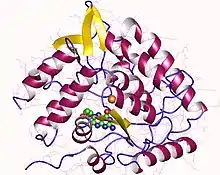Tryptophane hydroxylase
La tryptophane hydroxylase (TPH) est une oxydoréductase qui catalyse la réaction :
- L-tryptophane + tétrahydrobioptérine + O2 5-hydroxy-L-tryptophane + 4a-hydroxytétrahydrobioptérine.
Tryptophane 5-monooxygénase

| N° EC | EC |
|---|---|
| N° CAS | |
| Cofacteur(s) | Fe2+ |
| IUBMB | Entrée IUBMB |
|---|---|
| IntEnz | Vue IntEnz |
| BRENDA | Entrée BRENDA |
| KEGG | Entrée KEGG |
| MetaCyc | Voie métabolique |
| PRIAM | Profil |
| PDB | RCSB PDB PDBe PDBj PDBsum |
| GO | AmiGO / EGO |
Cette enzyme assure l'étape limitante de la biosynthèse de la sérotonine par hydroxylation du tryptophane en 5-hydroxytryptophane (5-HTP). Elle assure également la première étape de la biosynthèse de la mélatonine.
Avec la tyrosine hydroxylase (TH) et la phénylalanine hydroxylase (PAH), la tryptophane hydroxylase appartient à la superfamille des hydroxylases d'acides aminés aromatiques, qui catalysent des étapes clés de voies métaboliques importantes[2]. Tout comme la TH et la PAH, la TPH fait intervenir de la tétrahydrobioptérine (BH4) et de l'oxygène.
Notes et références
- (en) Lin Wang, Heidi Erlandsen, Jan Haavik, Per M. Knappskog et Raymond C. Stevens, « Three-Dimensional Structure of Human Tryptophan Hydroxylase and Its Implications for the Biosynthesis of the Neurotransmitters Serotonin and Melatonin », Biochemistry, vol. 41, no 42, , p. 12569-12574 (PMID 12379098, DOI 10.1021/bi026561f, lire en ligne)
- (en) Jeffrey McKinney, Knut Teigen, Nils Åge Frøystein, Clotilde Salaün, Per M. Knappskog, Jan Haavik et Aurora Martínez, « Conformation of the Substrate and Pterin Cofactor Bound to Human Tryptophan Hydroxylase. Important Role of Phe313 in Substrate Specificity », Biochemistry, vol. 40, no 51, , p. 15591-15601 (PMID 11747434, DOI 10.1021/bi015722x, lire en ligne)
Cet article est issu de wikipedia. Text licence: CC BY-SA 4.0, Des conditions supplémentaires peuvent s’appliquer aux fichiers multimédias.
